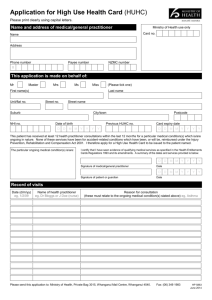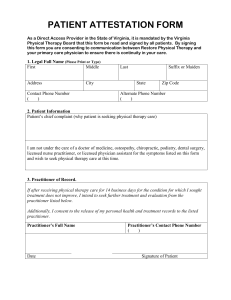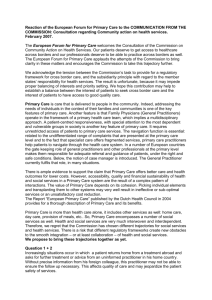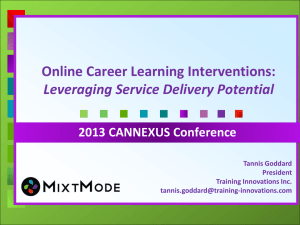The New Jersey Regional Early Intervention
advertisement
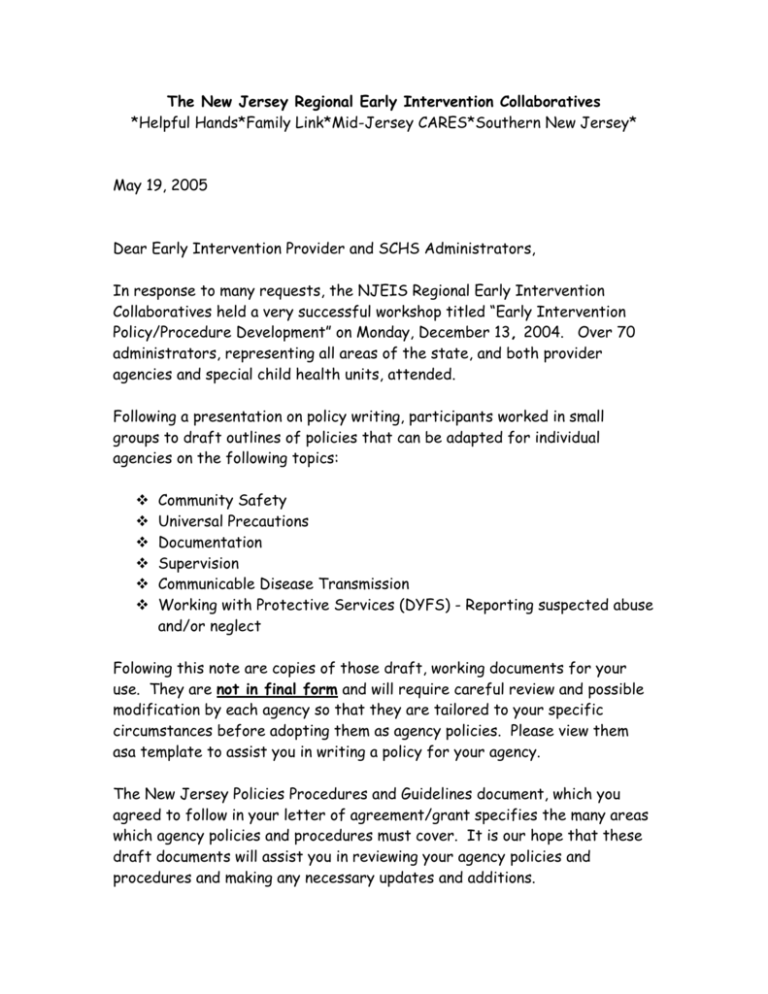
The New Jersey Regional Early Intervention Collaboratives *Helpful Hands*Family Link*Mid-Jersey CARES*Southern New Jersey* May 19, 2005 Dear Early Intervention Provider and SCHS Administrators, In response to many requests, the NJEIS Regional Early Intervention Collaboratives held a very successful workshop titled “Early Intervention Policy/Procedure Development” on Monday, December 13, 2004. Over 70 administrators, representing all areas of the state, and both provider agencies and special child health units, attended. Following a presentation on policy writing, participants worked in small groups to draft outlines of policies that can be adapted for individual agencies on the following topics: Community Safety Universal Precautions Documentation Supervision Communicable Disease Transmission Working with Protective Services (DYFS) - Reporting suspected abuse and/or neglect Folowing this note are copies of those draft, working documents for your use. They are not in final form and will require careful review and possible modification by each agency so that they are tailored to your specific circumstances before adopting them as agency policies. Please view them asa template to assist you in writing a policy for your agency. The New Jersey Policies Procedures and Guidelines document, which you agreed to follow in your letter of agreement/grant specifies the many areas which agency policies and procedures must cover. It is our hope that these draft documents will assist you in reviewing your agency policies and procedures and making any necessary updates and additions. Sincerely yours, Patti Ciccone Helpful Hands REIC Susan Marcario Family Link REIC Cynthia Newman Mid Jersey CARES REIC Jennifer Buzby Southern NJ REIC Draft Policy Outline Community Safety 1. Purpose –Community Safety is a priority for all staff member s who work in natural environments. This agency wants to ensure that staff is supported when providing services in communities that are established as high risk. To ensure safety risk of practitioners when in they are working in the natural environment 2. Revision History - N/A 3. Reference Documents – Confidentiality (Procedural Safeguards Policies and Procedures & FERPA) 4. Persons Affected – Administrators/Practitioners providing services/attending meetings in the natural environments Families and children receiving early intervention services 5. Policy – Agency will provide the following appropriate safeguards, necessary tools and guidelines to help ensure practitioners are informed about safety issues/options while working in the community. Agency will make reasonable efforts to ensure practitioner safety while working in the community. 6. Definitions a. Escort - Two individuals instead of one, an unarmed escort, or an armed escort. Professionally trained, agency-endorsed individuals who, for safety purposes, accompany practitioners working in the community. b. Natural Environments – a place where a child would be if he or she was not in need of early intervention including home and community settings where other children his/her age without disabilities may be found (i.e., daycare, YMCA classes, playground) c. Escort areas – locations where this is a potential for safety risks as determined by the agency based upon history, police intervention and the employee’s assessment. d. Responsibility – Program director is responsible for notifying police departments in each area in an effort to identify areas of concern. Program director is responsible for identifying potential locations for safety risks as determined by the agency based upon history, police intervention and the employee’s assessment. Program director is responsible for identifying known areas of concern and identifying those concerns to the practitioners. The program director is responsible for being the point person and discuss/make appropriate accommodations regarding the safety concern. The program director is responsible for arranging for periodic (TBD) training opportunities on the topic of community safety for agency employees. The practitioner is responsible for assessing each location and informing agency of potential safety concerns or unsafe issues within the home and outside the home (including potential life threatening situations, medical emergencies within the home, dyfs issues, weather conditions, etc.). The practitioner must sign a waiver if he/she refuses an escort when recommended by agency. The family is responsible for immediately notifying the agency/practitioner of any concerns that may result in unsafe conditions for the family and practitioner during the early intervention session. 7. Procedure – When it is established that a neighborhood is at high risk, a safety plan will be developed for each family home or other community site where services are to be provided (family meets you at the car, services provided in places within the community other than the home, more than one practitioner go to the home together, unarmed escort, armed escort) Practitioners must request agency support, such as an escort, if they determine someone in the home is acting violently or the area around the home does not appear safe. The practitioner must first try to leave the area immediately and then phone the agency designed person so that other staff or agencies can be notified of the unsafe situation. Staff must attend agency safety training Agency is not responsible for theft or damage to personal items The agency will keep track of where practitioners are at all times – even nights and weekends through log books (it is the practitioner’s responsibility to notify the agency of any schedule changes) Agency will notify staff of agency closings due to weather conditions. When the agency is not closed, practitioners are responsible to determine if weather conditions pose a safety threat and if so, notify the agency representative. (Inclement weather policy should be referred to) *Other policies that need to be referenced: Inclement weather DYFS Medical Emergencies Communicable Diseases Draft Policy Outline Universal Precautions 1. Purpose: The purpose of this policy is to provide information and procedures that will promote the health and safety of employees and clients and reduce the possibility of disease transmission during the delivery of early intervention services. This is good basic hygiene. 2. Revision History: 3. Reference Documents: Center for Disease Control; New Jersey Dept of Health and Senior Services; County Health Depts.; Dept. of Education; The Occupational Safety and Health Administration (OSHA); specific agency policy and procedures; LOA and grants (SCHS). 4. Persons Affected: This policy applies to EIP direct service staff (consultants), service coordinators and contractual staff. Any or all persons directly in contact with EIP children and family members. 5. Policy: All staff will implement UP to prevent the spread of communicable disease between Clients and employees, between clients, and between employees. The UP is implemented in a manner that respects the privacy of employees and clients. Practioners are not expected to change diapers or to clean up bodily fluids. This is the expectation of the parent/guardian. 6. Definitions: The definition from the Center for Disease Control states the following: “A simple set of effective practices designed to protect health workers and patients from infection with a range of pathogens including blood borne viruses. These practices are used when caring for all patients regardless of diagnosis.” a. You may have a child in your caseload that has an infectious disease. You may not know or have been informed of a diagnosis. The body fluids of all persons should be considered to contain potentially infectious agents (germs). The term body fluids includes: blood, semen, drainage from scrapes and cuts, feces, urine, vomitus, respiratory secretions (e.g. nasal drainage) and saliva. Contact with body fluids presents a risk of infection with a variety of germs. In general, however, the risk is very low and dependent on the type of contact made with it. Universal precautions are an infection control method which requires employees to assume that all human blood and body fluids are infectious. Universal precautions are any chemical or functional barrier which prevents the spread of the infectious process. I.E. hand washing, gloves, mask, and disinfecting solutions (bleach). 7. Responsibility: Program administrators are responsible for ensuring compliance with this policy. All intervention providers are expected to implement the Universal Precautions policy. 8. Procedure: a. All direct line staff must be initially trained during orientation period (documentation in employee file) with annual training and policy review (documentation will be maintained) b. Documentation that training took place c. Distribution of all appropriate supplies (gloves, masks, hand sanitizers) to all direct line service practioners. d. Observe appropriate hand washing techniques (see attachment A) e. Utilization of gloves (see attachment B) and appropriate disposal of f. When clinically indicated cleaning of toys being brought into the home g. Clean up of body fluids (1:10 bleach solution) h. Mechanism for reporting exposure – the practioner should notify their immediate supervisor Attachment A: Hand washing techniques – will be performed to prevent cross-contamination between clients and EIP personnel. Hands and other skin surfaces should be washed with soap and warm water immediately and thoroughly before and after client contact, if contaminated with body substances, before and after gloves are worn, and before preparing or eating food. Use soap, warm water and friction for hand washing. Lather and scrub for 15-30 seconds. Rinse well, beginning with fingertips, or dirty water runs off at the wrists. Dry hands on a paper towel. Use paper towels to turn off faucets. Use a waterless hand washing product for immediate use if hand washing facilities are not available in the home (i.e. Purell or some type of antibacterial solutions). Hand washing facilities should be located as soon as possible after leaving the home. Attachment B: Utilization of Gloves (when appropriate - *family needs to be informed of why you are utilizing precautions): the use of gloves (intact latex or vinyl) is important where the practioner has cuts, abraded skin, chapped hands, dermatitis, etc., when examining abrasions or when client has the same. Gloves are to be worn by the practioner when direct contact with any body substance is anticipated (blood, urine, pus, feces, saliva, drainage of any kind) Gloves are to be worn when contact with non intact skin is anticipated Remove gloves by pulling down over hands so that the soiled surface is inside and dispose of immediately. Gloves should not be washed or disinfected for reuse. Attachment C: Toy washing procedure The use of toys/equipment found within the home environment should always be the first priority. The practioner should always ask “why am I bringing toys into the home?” If it is determined clinically necessary to bring toys into the home environment, they should be left at the home until the child has mastered the skill be introduced. Use of dishwasher is recommended Submerging toys in 1:10 bleach solution and rinse thoroughly under running water and air dry. Separate clean from soiled toys during transport Attachment D: Incident reporting procedure *refer to agency policies Refer to the following websites for further information: Center for Disease Control Occupational Safety and Health Administration Draft Policy Outline Documentation 1. Purpose: To insure that a complete written record of the activities of the agency personnel with/on behalf of a child/family is kept on each child/family served in order to assure quality services are delivered. 2. Revision History Not yet applicable. 3. Reference Documents IDEA NJ State Plan for Early Intervention Procedural Safeguards Policies (Appendix A) Family Rights Booklet FERPA HIPPA 4. Persons Affected All early intervention personnel who provide services, make telephone calls, send mail or faxes or attend meetings on behalf of or with any early intervention family. This will always include practitioners and may include secretarial and administrative staff, as their responsibilities dictate. 5. Policy: All personnel will demonstrate competence and consistency in maintaining appropriate written records of all contacts with or on the behalf of the child/family. a. Face to face contact b. Telephone contacts c. Transmittal of documents d. Agency activities (team meeting) e. IFSP Meetings 6. Definitions 7. Responsibility: Director is responsible for assuring compliance with this policy. All practitioners are expected to implement program procedures. Office personnel are responsible for receiving, copying, storing, destroying and forwarding documentation appropriately. 8. Procedure i. ii. iii. iv. v. vi. vii. viii. A. Progress notes must include the following components: (practitioners may use the Home Visit Notes NCR form which includes these components) Date of activity Type of contact (telephone, face-to-face meeting, service delivery session, faxing or mailing information, etc) Who is involved in the contact Subject or content of the contact/activity Additional information Plan of action, follow up needed Time spent in activity Name and credential of person writing note, including signature. B. Notes must be written in an objective manner that accurately documents what is seen, observed, heard or actions the writer performed. Notes should be written in a non judgmental manner that avoids making conclusions or assumptions about the motivation or reason for the behavior of others’. An exception to this is in the case of notes describing a desired or undesired change in a child’s behavior that reflect on what the practitioner believes might be the reason for the change in the child’s behavior. These reflections should be described as practitioner thoughts or reflections and not labeled as factual information. C. Families may review and challenge the content of all documents in their child’s early intervention file. At the parent’s request early intervention files may be shared with other professionals and agencies. Accuracy and objectivity are essential to maintaining meaningful early intervention records. Group Brainstorming Will be different for SCHS and provider agencies Different from school settings due to services not being delivered at a central site. Types of subjective information, inference or analysis based on objective information. Verification logs, parent sick, holidays Accountability Billing Persons affected- if it’s not documented its not done Date stamping Progress logs Legibility How? Proof Communication between parent and provider Uniformity Content Progress notes Accuracy Components Purpose Ink, date, sign Organization Save the trees, minimize Identification, title, names, Labels, like 3 month review Communication between provider and SC Streamline Redundancy Parent rights booklet Logical progressions All contacts Time to document Proof of faxing Carbon paper Weeding out unnecessary docs, duplication Use of staff time during sessions to document Staff support while protecting parent rights Phone calls Parental/caregiver input Text on the page you sign/signatures not attached but on the page with the text Session logs- if don’t finish a page blot it out Initials at end of writing and circle it to show where you stopped writing Identifying signature at the bottom Reporting as in being able to assess over time that improvement is occurring Co-signing by participants. If another does the documentation, such as at an IFSP meeting. Memory aids Official folder Unofficial consulting (without the child/family there), transdisc approach Who, what, when, where, why and how Maintenance and destruction Draft Policy Outline Supervision 1. Purpose: To insure that employees and contractors of _________agency receive the supervision necessary to uphold the standards of practice established by the agency and the mission and vision of NJEIS. 2. Revision History 3. Reference Documents- NJEIS State plan; Personnel standards, Agency personnel policies, Contractual Agreements (independent contractors) Job Descriptions, EI Competencies, ASHA, Professional Scope and Practice Acts- ask Marilyn. 4. Persons Affected- All employees and contractors working within EI. 5. Policy- All employees will receive ongoing supervision in order to uphold the standards of practice established by the agency and the mission and vision of NJEIS. All independent contractors will be monitored to insure contract performance. 6. Definitions Employees Contractors/Consultants NJEIS Practitioners 7. Responsibility-The Early Intervention Unit Coordinator/Program Administrator is responsible for ensuring compliance with this policy. 8. Procedure: 9. Employees 10. Every employee will have an assigned specified supervisor. On at least an annual basis, the supervisor will meet with employee to develop an Individualized Employee Supervisory Plan. The plan will specify activities of supervision for the year which may include: i. ii. iii. iv. v. vi. vii. viii. ix. x. Discipline specific procedures Observation schedule (minimum one per year). Mentoring Activities Attendance of Staff Meetings Review of documentation: verification logs, progress notes, Chart reviews Participation in a minimum of 4 staff trainings per year: Confidentiality, psg- see ei guidelines Monitoring continuing education Monitoring continuing licensure requirements Family contacts/surveys Annual Performance Review 11. Consultants Every consultant will have an assigned contract manager. The contract manager is responsible for developing a contract which states specific standards of practice. The contract manager is also responsible for monitoring the performance of the contractor. Contract performance management activities may include: i. Discipline specific procedures ii. Observation schedule (minimum one per year). iii. Attendance of Staff Meetings iv. Review of documentation: verification logs, progress notes, chart reviews v. Participation in a minimum of 4 staff trainings per year: Confidentiality, psg- see ei guidelines vi. Monitoring continuing education vii. Monitoring continuing licensure requirements viii. Family contacts/surveys 12. Brain storming-The workgroup agreed that the topic of supervision covers a broad range of activities. The following is a list of items to be considered when developing an agency specific supervision policy: discipline specific, general supervision, self assessment requirements, performance evaluations and the links between them, management unit vs. eip’s, personnel-enrollment/hiring, personal qualifications, orienting, professional development, tools to supervise-observation, mentoring, paraprofessionals-different levels, disciplinary action, continuing ed requirements for disciplines, continuing employment requirements by agency and system- tracking of credentials, are they getting in 3 month reviews, link job descriptions to performance evaluations, communication skills provide services in accordance with the mission and vision of the early intervention system. (agency/program standards) staff is not just practitioners- also administrators. Draft Policy Outline Communicable Diseases 1. Purpose: To help prevent exposure and spread of communicable diseases to the EIP staff and the families receiving EIP services 2. Revision History : NA 3. Reference Documents : IDEA, NJ Policies and Procedures, EI Resource Manual, OSHA 4. Persons Affected: All EIP staff including: administrators, practitioners, and other persons listed as members of the IFSP team for a child, who have direct contact with the child/family 5. Policy: A. EI staff meet the personnel medical clearance requirements of the agency prior to being hired B. EI staff are informed about communicable diseases C. EI staff know and use Universal Precautions D. EI staff educate families about their responsibilities to help prevent exposure to illness and communicable diseases. 6. Definitions : Appendix _, (list of Communicable Diseases and Conditions) 7. Responsibility: A. Program Director is responsible for making sure: I. practitioners know and use Universal Precautions II. practitioners receive orientation and ongoing training on all policy and procedures to include communicable diseases and conditions III. practitioners know how to inform agency/program director of a known communicable disease in a family’s home immediately upon learning this information IV. practitioners know when to stay or not to stay in a family’s home upon learning of an illness or communicable disease. Appendix _ (to be created) V. practitioners know when and how to inform agency and family when they have a communicable disease VI. practitioners know that they must review Family Handbook with the family and talk about the family responsibilities 8. Procedure: A. Program Director will provide orientation for new staff to occur prior to starting services; documentation of participation will be kept in individual personnel files B. Practitioner will: I. inform provider agency and Service Coordinator of know illness or communicable disease in a family’s home immediately. Depending on the type of illness the practitioner will follow guidelines in Appendix C (to be created) II. immediately inform agency and family when they have a communicable disease III. upon first visit to the family’s home will provide family with the agencies communicable disease policy, discuss and document conversation in progress notes IV. provide family with his/her phone number(s) and agency number(s) so the family can contact him/her as soon as they know of an illness or communicable disease in the home C. Families will: I. understand that they have a responsibility to inform all members of the IFSP team of communicable diseases so as not to spread illness to other children in EI II. contact the practitioner as soon as they know of an illness or communicable disease in the home III. keep siblings and other members of the family from participating in EI sessions if they are ill IV. support the practitioner by handling the child during an EI session when the child has outward sign of congestion and other similar illnesses Draft Policy Outline Suspected Child Abuse/Neglect 1. Purpose Any employee who has reasonable cause to believe that a child has been or is being subjected to any form of hitting; corporal punishment, abusive language, ridicule; harsh, humiliating or frightening treatment, or any other kind of child abuse, neglect or exploitation by any adult, is required by State Law to report the concern immediately to the Division of Youth and Family Services (DYFS) Office of Child Abuse Control 24 hour hotline (English & Spanish) 1-877-NJABUSE; or to any county DYFS District Office. 2. Revision History Date 12/13/04 Revision Change Reference 3. Reference Documents The reference sheets regarding titles 9 & 30 and the DYFS Manual of Selected Status and Court Rules. 4. Persons affected All clinicians (special educators, occupational therapists, speech therapists, physical therapist, nurses, paraprofessional, etc) and ancillary staff; any person having reasonable cause to believe that a child has been abused or neglected shall report it immediately to DYFS ( N.J. S.A. 9:68.10). 5. Policy ABC Early Intervention Agency is committed to a violence free society. However, violence is witnessed throughout the lifespan in families in all social, economic, ethnic and racial groups. ABC Early Intervention Agency’s response to potential abuse or neglect is to report possible abuse/neglect immediately to DYFS for investigation. 6. Definitions Child abuse - Physical, psychological, or sexual abuse, neglect or abandonment of a child from birth to 18 years of age (N.J. S. A. 9:6-1, N.J. S. A. 9:6-3.2, 9:6-8.9d and f, and 9-6-8.21). Neglect – A dependent individual (child, elder or a disabled person) whose physical, mental or emotional condition has been impaired or is in danger of being impaired as the result of the failure of the caretaker to exercise a minimum degree of care (1) to supply adequate food, clothing, shelter, education or medical care or (2) to supply adequate supervision for the dependent individual (Governor’s Task Force on Child Abuse and Neglect, 1988). Physical abuse – Infliction of physical injury by other than accidental means such as slapping, choking, burning, punching, kicking, pushing or the use of objects as weapons. (Helton, 1987) Psychological abuse – Includes verbal and other forms of harassment such as threatening bodily harm, humiliation, and shaming, denigrating or physical isolation. (Esposito, 1993) Sexual Abuse – Committing a sexual act with an individual who is unable to give consent or against the wishes of a competent adult. Abandonment – Willful abandonment of a dependent individual by a caretaker (Governor’s Task Force on Child Abuse and Neglect, 1988). Parent or guardian - Any natural parent, adoptive parent, foster parent, stepparent, or any person who has assumed responsibility for the care, custody or control of a child or upon whom there is a legal duty for such care (e.g. school teachers, institutional staff, etc). Domestic Violence – Occurrence of physical, psychological, verbal or sexual abuse between an individual and another person who is a present or former household member or is related by blood. This is regardless of gender or sexual orientation. Elder Abuse or Abuse of the Disabled – Abuse towards the elderly or towards a disabled individual who is dependent on the abuser for care. This may include physical, psychological, or sexual abuse, neglect or abandonment, financial exploitation or self- neglect (Yurkow, 1993). Court – The Superior Court, Chancery Division (Family Part), commonly referred to as “The Family Court”. 7. Responsibility Any practitioner making a report in “good faith” of child abuse and neglect shall have immunity from any civil or criminal liability (N.J. S. A. 9:6-8.13). 8. Procedure a. Any practitioner having reasonable cause to believe a child has been abused or neglected will immediately contact by telephone DYFS through its referral screening division. b. If there is immediate risk, the practitioner should also contact the local police department at 911. c. ***The practitioner may contact their supervisor, although it is not required, for discussion regarding the referral prior to contacting DYFS. d. If the situation is such that the child can not be left safely, the practitioner should remain in the home and contact DYFS and their department administration for direction. e. Reporting to DYFS may be done anonymously. f. The practitioner will contact their administrator immediately after contacting DYFS regarding the referral. g. The practitioner will document in a progress note all actions taken; including a complete assessment of the DYFS referral, DYFS response, and the DYFS contact information. h. Early Intervention services provided to the child and family will be coordinated directly between the practitioner and their administrator. i. Family will be contacted by ABC Early Intervention Agency practitioner and administrator regarding ongoing Early Intervention services. j. With family’s written consent, the ABC Early Intervention Agency will work with the DYFS caseworker and family. k. This policy on reporting child abuse/neglect and red flags regarding suspected abuse/neglect will be reviewed annually. l. Annual reporting of child abuse/neglect will also include a discussion regarding issues that may be unique to children with disabilities, e.g. – a child with cerebral palsy may have more bruises on their legs due to falls than the typical 2 year old. Help us plan future meetings for you!!!! Please rank these topics, on a 1 to 5 scale (1 for least interested and 5 for most interested) to help us plan the next administrator meeting. System Paperwork Conflict Resolution with Families General Supervision Billing Procedural Safeguards Comments: Please fax your response to: 908-964-6091, attention Chitra.



